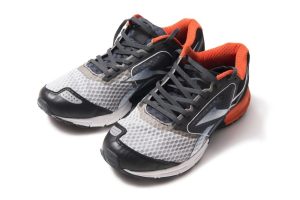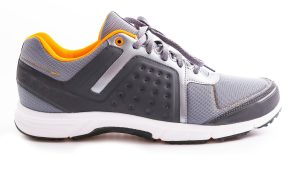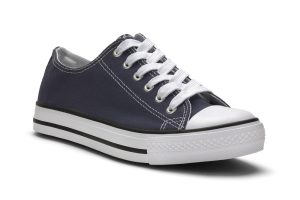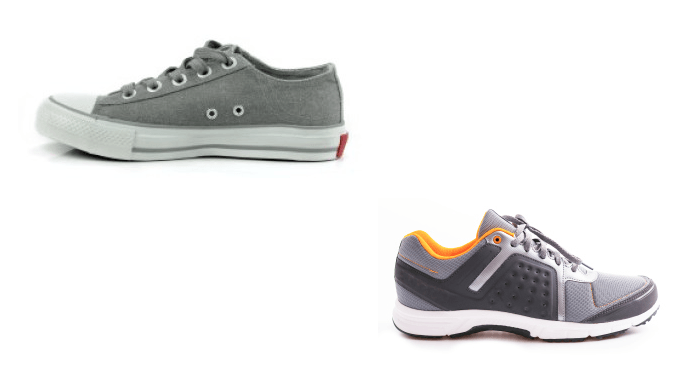Vulcanized Shoe Construction vs. Cold Cement Process
In this article, we will discuss the difference between vulcanized shoe construction and cold cement shoe construction. Vulcanized shoe construction is a much older technology. In the 1980s, modern cold cement construction replaced vulcanized construction. However, fashions change and the vulcanized shoe made a huge comeback in 2010.
Cold cement construction allows the use of modern lightweight plastic, foam, and mesh materials due to the lower temperatures required for bonding. Every modern high-performance athletic shoe for running, basketball, etc… is made by the cold cement process. This is how Nike makes shoes.
The vulcanized shoe construction process is the classic way to make a sneaker. This is how Converse All-Stars and Vans skate shoes are made. Due to the high temperature required to vulcanize, or cook the rubber outsole, the material options are limited. Canvas and suede leather are common.
The Shoe Dog would like to tell you about how vulcanized shoes are made.
Have a look!
The Shoe Dog would like to tell you about the difference between vulcanized construction and cold cement process.
Cold Cement Shoe Assembly Process:
 In the cold cement process, the shoe upper can be paired with a Strobel bottom. For this classic jogger style, the outsole covers the edge of the upper so a Strobel bottom will make the shoe lighter and more flexible.
In the cold cement process, the shoe upper can be paired with a Strobel bottom. For this classic jogger style, the outsole covers the edge of the upper so a Strobel bottom will make the shoe lighter and more flexible.
The upper is steamed to soften the materials and the last is inserted and pulled tight. Once the last is tight inside the upper, a second lasting machine pulls the heel edge. With the last secured inside the upper, temporary shoelaces are pulled tight and the upper is cooled so it shrinks to the last.
The shoe may have a plastic or fabric part installed on top of the tongue to protect the surface from damage and drift during the lasting operations.
While the upper is being lasted, the sole unit is being prepared. In this case, a rubber sheet sole is combined with an EVA foam cushioning component and cemented inside. This is done in a separate process that’s called stock fitting.
In this article, we will discuss the difference between vulcanized shoe construction and cold cement shoe construction. Vulcanized shoe construction is a much older technology. In the 1980s, modern cold cement construction replaced vulcanized construction. However, fashions change and the vulcanized shoe made a huge comeback in 2010.
Cold cement construction allows the use of modern lightweight plastic, foam, and mesh materials due to the lower temperatures required for bonding. Every modern high-performance athletic shoe for running, basketball, etc… is made by the cold cement process. This is how Nike makes shoes.
The vulcanized shoe construction process is the classic way to make a sneaker. This is how Converse All-Stars and Vans skate shoes are made. Due to the high temperature required to vulcanize, or cook the rubber outsole, the material options are limited. Canvas and suede leather are common.
Shoe Sole Cementing
Now that the upper is tightly lasted and the outside unit is complete, the two pieces can come together. The rubber sole unit will receive a coating of primer and cement. The outsole will get its own special primer designed for EVA and rubber. The shoe upper is also prepared with its own special primer and cement. After the contact cement and primer have dried in the heating tunnels, the two pieces are joined together by hand. A skilled worker aligns the upper and outsole together, then places the shoe in a hydraulic press. The shoe will go through three pressing operations, usually, they are all done with one machine. A vertical press, toe and heel press, and side press. This ensures there is full contact between the upper and outsole. Once the shoe is pressed together it’s often put in the cooling tunnel to set the glue. After the cooling tunnel a shoe de-lasting machine is used to push the last out of the shoe without wrinkling the upper. Now the sneaker is complete and the worker can insert the footbed. The footbed may be molded EVA with a fabric cover or flat, sheet-cut foam. The flat, die-cut footbed is usually cemented inside the shoe, while molded footbeds are most often removable. The new sneaker is ready for the final QC inspection, a quick check for any loose threads, cleaning, packing, and shipping.
Vulcanized Shoe Construction:

Board Lasting Operations
In vulcanized construction, the last must be aluminum to survive the oven temperature. Metal lasts also heat up and cool down quickly. The first step is to lightly cement the lasting board to the bottom of the last, just enough to hold it in place during the lasting operation. The lasting board is a paper fiberboard that provides stiffness to the finished shoe.
Lasting boards are made from different materials and can be stiff or flexible, thin, or thick. Now, the last and upper are taken to the lasting machine. The toe lasting machine pulls the upper down onto the last and securely bonds the two parts together in one operation. Once the shoe heel and waist of the shoe are lasted, the upper is ready for the outsole.
The first step of the vulcanized outsole assembly process is similar to the cold cement process. The upper and the rubber sole parts all receive their coating of primer and cement. Now, the rubber bottom with the cushioning wedge is bonded together with the upper.
The foxing tape covers the rubber outsole part and overlaps up onto the upper. The foxing tape must cover 5mm of the upper to have a solid bond. The shoe can now have the extra toe tape added, then a rear logo will be applied to cover the joining seam.
With the tape applied, it is time to rip off any extra rubber using a hot knife and to make sure there are not any gaps. The sole will get a quick pressing to make sure the parts are fitting correctly.
The Vulcanizing Oven
With the last still inside, the shoe is placed on a steel rack so it can be wheeled onto the oven.
The shoe will be “cooked” in the vulcanizing oven for several hours. The shoe is heated long enough for the uncured foxing tape and the sole unit to fuse together.
After cooling, the shoe last is removed, the footbed is inserted, and the laces are attached.
The shoes are now ready for final inspection, cleaning, and packing.


